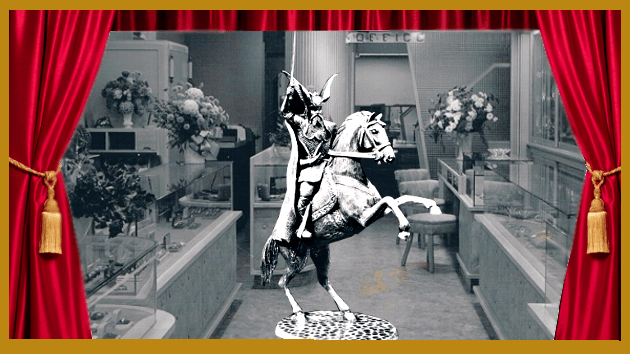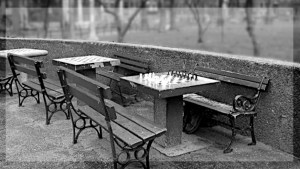
Jensen's Masterpiece
This is a story of a trinity: a store, a man and a masterpiece.
Nearly a century ago, a man named William Lindenberg opened a jewelry store on 1314 E. 45th St. in Seattle. This was in 1924. On the other side of town two men, Anchor O. Jensen and Fred J. Nielsen were working out of a shop located in the Ranke Building on 420 Pike St.
Anchor and Jensen, as bench jewelers, probably did some work for Lindenberg and were acquainted. In 1944 they bought out Lindenberg and moved to his prized University area location.

Around 1930-1, Anchor Jensen began a decade long spare-time project that would prove to be his legacy.
Anchor Otto Johannes Jensen was an artist and a man of many talents and interests. Primarily, he designed and crafted jewelry and intricate silver pieces for profit but none of there things could compare with the chess set he created for his personal gratification.
About his chess set after it was first displayed in 1941, "the American Weekly" wrote:
In one respect Mr. Jensen's spectacular modern contribution to the ancient game of chess is unique. He did not stick to familiar patters but chose to make half of his men in the likeness of ancient Romans and the other half to represent the Vikings who gave the legions of the Caesar a tough scrap about 1900 years ago.
The inspiration for the 32 figurines that the Seattle jeweler so patiently fashioned came to him while he was reading a chapter in History which told the story of the invasion of Gaul by the cohorts of Rome.
He went about his job like an archeologist piecing together a picture of the long-lost past. He collected drawings and sketches of the outfits worn by the Vikings and Romans. No detail was too small for him to study. He read descriptions of the arms used by the belligerents and made great sheafs [sic] of notes.
He then set to work sculpturing models of his doughty chessmen in wax. From these wax figures he made molds into which he poured molten silver. One by one the little silve figures were finished by hand - until every stirrup and sword-hilt and spearhead was perfect. Long before the two armies were complete, the jeweler had offers to sell them them when they were ready for action on a field of copper and silve quares framed in a border of black marble.
Devotees of the game of chess are struck by the feeling of dramatic action that Mr. Jensen has put into his 32 fighting men. Never, they say, have they seen a set of chessmen that makes the game seem so much like real warfare, on which it is based.
It is probable that the Seattle silversmith has turned out the most expensive set of toy soldiers to be found in this war-torn world.
Here is the silver chess set:
 Roman Knight
Roman Knight Close up of the Roman Knight
Close up of the Roman Knight Viking King
Viking King Close up of the Viking King
Close up of the Viking King Entire Jensen Chess set
Entire Jensen Chess set Roman Queenside
Roman Queenside Roman Kingside
Roman Kingside Viking Queenside
Viking Queenside Viking Kingside
Viking KingsideAnchor died at age 91 in Seattle on May 16, 1983.
He was granted honorary lifetime membership to the Seattle Chess Club after the set was completed. A 1975 article ["Seattle Times," Nov. 17] claims the set was "once used for a championship game."
He was also a member of the Seattle Amateur Movie Club. Jensen's amateur cinematography produced two prizing winning films. Unlike the great majority of amateur filmmakers, Jensen used 8mm rather than 16mm film. His first prize winning film was the 1942 entry, "Ten Pretty Girls." The New York City amateur Movie Club expressed in its newsletter, The New York Eight, "Ten Pretty Girls is gorgeous, glamorous Kodachrome, easily one of the best amateur movies of the year. ... It should be shown far and wide, especially to some of our somewhat snooty friends in the 16mm. field."
His second award winning film was the 1945, "Alpine Vixen." In its Dec. 1945 issue, "Movie Makers" magazine wrote, "Anchor O. Jensen has raised 8mm. color filming to a level that movie makers in any width would do well to emulate. Particularly in the double exposed sequence of the Titian haired girl in a cave of crystals does he prove his skill with the camera."

but in Seattle it was much more personal:
 ("view image" for full size)
("view image" for full size) Jensen working on his figurines.
Jensen working on his figurines. Jensen playing the actress from the newspaper article.
Jensen playing the actress from the newspaper article.
In 1962 Porter moved the store to 4501 University Way NE.
So what does this history of the store have to do with the Jensen chess set?
The chess set, subsequent to it's original publicity, was pretty much hidden away. After Warren Porter bought the store, the chess set, still owned by Jensen, was displayed on several occasions at the new store.
 One occasion was the grand opening of the new store in 1962.
One occasion was the grand opening of the new store in 1962.As a testimony to the set's valuation, the article stated: "The set can be viewed from a closed display case. There will be a guard standing nearby. At night, the store's ultrasonic security system takes over but there will be an observer outside." It was also insured for $100,000.
Most of my information comes from the store's archives provided to me by the owner, Joe Waldmann. Joe bought the business from Mr. Porter whose health was failing (he passed away in 2004) in 1999. Joe, a chess aficionado, stumbled across the existence of the chess set while going through the attic of the store. Contacting the former store manager, a 20 year employee of Mr. Porter, he learned of how Jensen's set has been showcased at the store. Maybe that would have been that except by some astonishing matter of chance he was contacted by a Mr. Wood who desired an appraisal, for tax purposes, of a item he planned to donate to the MOHAI (the Seattle Museum of History and Industry where the set had been once exhibited). The item turned out to be Jensen's masterpiece. The trail is a bit muddied but it seems Mr. Jensen, for whatever reason, sold the set to the father of a poet, name unknown, who gave it to his son as a gift. The poet's fortunes changed and he was forced to give it to Mr. Wood in lieu of some money owed. Joe told me, "I appraised it at $92,470.00 in August of 2001." The appraisal also gave him the opportunity to admire the set up close.
Joe Waldmann was compelled to move the business yet again due to a deterioration of the neighborhood which kept clients away.
Porter Jensen Jewelers is now located (and Joe Waldmann can be reached) at:
6401 Lake Washington Blvd. SE, Newcastle WA, 98056
Contact email: info@porterjensen.com
phone: (425) 793-3730
website: www.porterjensen.com
My part —telling the chess world about this marvelous creation—is done. Mr. Waldmann's part —enticing the MOHAI to exhibit it— is just beginning. Part of the plan is to use this article and any positive comments it might generate as a showcase to demonstrate that interest does exist among chess lovers and art lovers.
So, please comment and give your support.
P.S.






